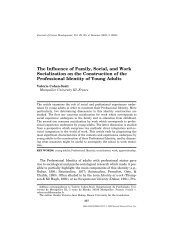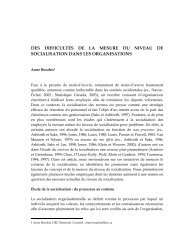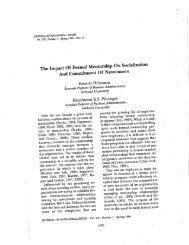Training in the 21st Century: Some Lessons from the Last One - Free
Training in the 21st Century: Some Lessons from the Last One - Free
Training in the 21st Century: Some Lessons from the Last One - Free
Create successful ePaper yourself
Turn your PDF publications into a flip-book with our unique Google optimized e-Paper software.
42 Haccoun and Saks<br />
Appendix A presents a <strong>Tra<strong>in</strong><strong>in</strong>g</strong> Analysis Grid (TAG)<br />
which could be of use to practitioners to frame and to<br />
guide <strong>the</strong>ir decision mak<strong>in</strong>g.<br />
TAG def<strong>in</strong>es a number of dimensions (def<strong>in</strong>ed <strong>in</strong><br />
Appendix A) which are known to <strong>in</strong>fluence tra<strong>in</strong><strong>in</strong>g<br />
outcomes. The user would be required to analyse each of<br />
<strong>the</strong> tra<strong>in</strong><strong>in</strong>g modules or activities (for example lectures,<br />
discussions, practices etc.) and to rate <strong>the</strong> activity as to<br />
<strong>the</strong> degree to which it is designed to <strong>in</strong>fluence die<br />
parameter def<strong>in</strong>ed by <strong>the</strong> rows of <strong>the</strong> matrix. For example,<br />
activity 1 might be an <strong>in</strong>itial lecture designed to<br />
expla<strong>in</strong> <strong>the</strong> basic concepts to be discussed dur<strong>in</strong>g <strong>the</strong><br />
course. Such a lecture might enhance motivation by<br />
<strong>in</strong>creas<strong>in</strong>g <strong>the</strong> perceived importance of <strong>the</strong> tra<strong>in</strong><strong>in</strong>g<br />
content and it might impact on declarative learn<strong>in</strong>g.<br />
Typically, such a lecture would not be designed to<br />
<strong>in</strong>fluence self-efficacy or procedural learn<strong>in</strong>g. By summ<strong>in</strong>g<br />
<strong>the</strong> rows across <strong>the</strong> columns one would obta<strong>in</strong> an<br />
overall score reflective of <strong>the</strong> degree to which <strong>the</strong> course,<br />
as a whole, is focussed on enhanc<strong>in</strong>g each of <strong>the</strong> items<br />
listed <strong>in</strong> <strong>the</strong> rows. In such a manner <strong>the</strong> practitioner<br />
would have an overall scor<strong>in</strong>g scheme for <strong>the</strong> tra<strong>in</strong><strong>in</strong>g<br />
program. Now, enter<strong>in</strong>g <strong>the</strong> <strong>in</strong>formation collected on<br />
<strong>the</strong> TAG simultaneously with <strong>the</strong> analysis of <strong>the</strong> tra<strong>in</strong><strong>in</strong>g<br />
situation would allow for better decision mak<strong>in</strong>g. For<br />
example, a course may be planned for an environment<br />
which is unlikely to be supportive. In this case <strong>the</strong> course<br />
content should provide lots of motivationally driven<br />
activities. The exam<strong>in</strong>ation of <strong>the</strong> TAG results will help<br />
estimate <strong>the</strong> degree to which <strong>the</strong> course proposed meets<br />
that requirement Fur<strong>the</strong>r, <strong>the</strong> use of TAG can guide <strong>the</strong><br />
development of new and <strong>the</strong> modification of exist<strong>in</strong>g<br />
courses.<br />
Design<strong>in</strong>g <strong>Tra<strong>in</strong><strong>in</strong>g</strong> Programs and Transfer<br />
Interventions<br />
The design of tra<strong>in</strong><strong>in</strong>g programs has traditionally been<br />
<strong>in</strong>fluenced by learn<strong>in</strong>g <strong>the</strong>ory. Most tra<strong>in</strong>ers know <strong>the</strong><br />
importance of ma<strong>in</strong>ta<strong>in</strong><strong>in</strong>g strict stimuli-response<br />
parallelism between work and tra<strong>in</strong><strong>in</strong>g contexts, and<br />
most programs are designed to provide feedback,<br />
multiple examples etc. However, <strong>in</strong> recent years a<br />
grow<strong>in</strong>g number of studies have been conducted which<br />
show different and profitable ways of design<strong>in</strong>g tra<strong>in</strong><strong>in</strong>g<br />
programs, and <strong>in</strong> so do<strong>in</strong>g, improv<strong>in</strong>g <strong>the</strong>m. Latham and<br />
Seijts (1997) have called for a move away <strong>from</strong> <strong>the</strong><br />
exclusive reliance on <strong>the</strong> pr<strong>in</strong>ciples of experimental<br />
psychology for maximiz<strong>in</strong>g transfer, toward a much<br />
broader and <strong>in</strong>tegrative approach that <strong>in</strong>cludes pr<strong>in</strong>ciples<br />
and <strong>the</strong>ory <strong>from</strong> cl<strong>in</strong>ical, counsell<strong>in</strong>g, and sport<br />
psychology.<br />
Gary Latham (Frayne & Latham, 1987, Latham 8c<br />
Fravne, 1989) as well as American colleagues Tim<br />
Baldw<strong>in</strong> (Baldw<strong>in</strong>, 1992) and Marilyn Gist and her<br />
colleagues (Gist et al., 1990, 1991; Stevens et al., 1993)<br />
have all been very active proponents of <strong>in</strong>tegrat<strong>in</strong>g<br />
modell<strong>in</strong>g and self-management as a generalized strategy<br />
for tra<strong>in</strong><strong>in</strong>g. Well grounded <strong>in</strong> social cognitive <strong>the</strong>ory<br />
(Bandura, 1986) and easily operationalized, <strong>the</strong>se<br />
approaches have been repeatedly shown to be effective<br />
for enhanc<strong>in</strong>g self-efficacy and transfer. Although <strong>the</strong>re<br />
rema<strong>in</strong>s little question as to <strong>the</strong> dramatic impact that<br />
<strong>the</strong>se techniques can have on <strong>the</strong> acquisition and<br />
transfer of learned skills, <strong>the</strong> development of tra<strong>in</strong><strong>in</strong>g<br />
programs structured around <strong>the</strong>se cognitive-behavioural<br />
approaches is quite distant <strong>from</strong> <strong>the</strong> typical ways <strong>in</strong> which<br />
tra<strong>in</strong><strong>in</strong>g programs are structured. It is for this reason that<br />
<strong>the</strong> present authors (see Haccoun, 1992; Haccoun, 1997;<br />
Saks & Haccoun, 1996; and Saks et al., 1996) have<br />
proposed merg<strong>in</strong>g traditional tra<strong>in</strong><strong>in</strong>g design with some<br />
of <strong>the</strong>se new social cognitive <strong>the</strong>ory based advances.<br />
THE TRANSFER ENHANCEMENT PROCEDURE (TEP)<br />
In <strong>the</strong> last several years, we have proposed that organizational<br />
tra<strong>in</strong>ers engage <strong>in</strong> a strategic shift (Haccoun, 1992;<br />
Haccoun, 1997; Saks & Haccoun, 1996; Saks et al., 1996).<br />
We have suggested that tra<strong>in</strong>ers add to exist<strong>in</strong>g tra<strong>in</strong><strong>in</strong>g<br />
programs <strong>in</strong>tervention modules designed to specifically<br />
enhance skill acquisition and transfer. These <strong>in</strong>terventions,<br />
which we refer to as Transfer Enhancement<br />
Procedures or "TEPs", make profitable use of <strong>the</strong> research<br />
knowledge ga<strong>in</strong>ed over <strong>the</strong> last decade or so.<br />
Essentially, <strong>the</strong> TEP approach requires tra<strong>in</strong>ers to<br />
conceptually separate <strong>the</strong> substantive content of a<br />
tra<strong>in</strong><strong>in</strong>g program <strong>from</strong> <strong>the</strong> parameters which will facilitate<br />
learn<strong>in</strong>g and transfer.<br />
The research literature has taught us that <strong>in</strong>itial<br />
tra<strong>in</strong>ee motivation and self-efficacy can have a decided<br />
impact on learn<strong>in</strong>g and transfer. It has also taught us<br />
that <strong>the</strong> degree to which <strong>the</strong> tra<strong>in</strong>ee is prepared for <strong>the</strong><br />
application milieu, at <strong>the</strong> end of a tra<strong>in</strong><strong>in</strong>g program is of<br />
paramount importance. Therefore, <strong>the</strong> tra<strong>in</strong><strong>in</strong>g function<br />
should <strong>in</strong>tervene, pursuant to <strong>the</strong> TEP concept at one or<br />
both of <strong>the</strong>se levels prior to or at <strong>the</strong> end of a tra<strong>in</strong><strong>in</strong>g<br />
program.<br />
fre-tra<strong>in</strong><strong>in</strong>g <strong>in</strong>terventions<br />
Initial motivation levels are critical to tra<strong>in</strong><strong>in</strong>g success<br />
because <strong>the</strong>y def<strong>in</strong>e, <strong>in</strong> part, <strong>the</strong> <strong>in</strong>itial attentional<br />
resources which will be available dur<strong>in</strong>g tra<strong>in</strong><strong>in</strong>g (Noe,<br />
1986). Therefore, it is important for tra<strong>in</strong>ers to enhance<br />
motivation at <strong>the</strong> onset of tra<strong>in</strong><strong>in</strong>g.<br />
Us<strong>in</strong>g a VIE framework, it seems clear that motivation<br />
to learn and motivation to transfer will be heightened to<br />
die degree that <strong>in</strong>dividuals attach high valence to <strong>the</strong><br />
tra<strong>in</strong><strong>in</strong>g as well as high expectations that <strong>the</strong>y can, by<br />
marshall<strong>in</strong>g <strong>the</strong>ir efforts, successfully learn and accomplish<br />
<strong>the</strong> tra<strong>in</strong>ed task on <strong>the</strong> job. Tra<strong>in</strong>ers might consider





